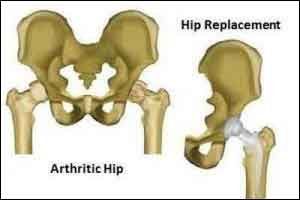- Home
- Editorial
- News
- Practice Guidelines
- Anesthesiology Guidelines
- Cancer Guidelines
- Cardiac Sciences Guidelines
- Critical Care Guidelines
- Dentistry Guidelines
- Dermatology Guidelines
- Diabetes and Endo Guidelines
- Diagnostics Guidelines
- ENT Guidelines
- Featured Practice Guidelines
- Gastroenterology Guidelines
- Geriatrics Guidelines
- Medicine Guidelines
- Nephrology Guidelines
- Neurosciences Guidelines
- Obs and Gynae Guidelines
- Ophthalmology Guidelines
- Orthopaedics Guidelines
- Paediatrics Guidelines
- Psychiatry Guidelines
- Pulmonology Guidelines
- Radiology Guidelines
- Surgery Guidelines
- Urology Guidelines
Blood metal ion levels can predict risk of ARMD in hip replacement patients

Patients with "metal on metal" (MoM) artificial hips are at risk of complications caused by adverse reactions to metal debris (ARMD). A study in the September 20, 2017 issue of The Journal of Bone & Joint Surgery confirms that blood metal ion levels specific to the type of hip implant used can help predict patients who are at low risk of ARMD. The journal is published in partnership with Wolters Kluwer.
Using implant-specific cutoff points resulted in fewer missed cases of ARMD compared to using fixed thresholds currently recommended by US and UK regulatory authorities, according to the report by Gulraj S. Matharu BSc(Hons), MRCS, MRes, DPhil of University of Oxford and colleagues. Their findings offer a refined approach to predicting the risk of ARMD in patients with two widely used types of metal-on-metal hip replacements: the Birmingham Hip Resurfacing (BHR) implant and the Corail-Pinnacle implant. The research was funded by Arthritis Research UK (grant reference number 21006).
Blood Metal Ion Levels Identify Patients at Low Risk of ARMD
Patients can develop adverse reactions to the metal debris generated from the implant surfaces sliding over each other in the artificial joint. Measuring levels of chromium and cobalt ions in the blood--reflecting the presence of small particles from the worn implant surfaces--is recommended as part of patient follow-up for early detection of ARMD. However, there is no agreement as to the specific blood metal ion levels that should raise concern after MoM hip replacement. Previous studies by Dr. Matharu and colleagues suggested that using implant-specific thresholds could improve the ability to detect patients at low risk of developing ARMD.
To confirm this approach, the researchers performed an external validation study including 710 patients (803 hips) who underwent MoM hip replacement with one of the two aforementioned MoM hip prostheses at three European hospitals. Implant-specific versus fixed regulatory authority cutoff points for blood metal ion levels were tested for their ability to correlate with clinically diagnosed ARMD, rates of which were 12 percent after single-hip BHR replacement, 18 percent after double-hip BHR replacement, and 7 percent after single-hip Corail-Pinnacle replacement.
The implant-specific cutoff points performed well in distinguishing between patients with and without ARMD. Sensitivity--the percentage of patients with ARMD who had ion levels above the implant-specific threshold--ranged from 65 to 79 percent in the three groups. Just as important, the negative predictive value--the percentage of patients without ARMD who had ion levels below the threshold--was 93 to 97 percent across groups.
Overall, the implant-specific cutoff points identified all but 2.8 percent of ARMD cases. In contrast, the fixed regulatory authority cutoff points missed up to 6.5 percent of cases.
Early identification of ARMD is important, especially for some patients where early revision (implant removal and replacement) can reduce complications and give a better outcome for the patient. The new findings confirm the value of implant-specific blood metal levels in helping assess the risk of ARMD after MoM hip replacement.
Using these cutoff points helps to pinpoint patients who should be monitored more closely for possible ARMD, while also minimizing the use of additional testing in patients unlikely to have or develop ARMD. But Dr. Matharu and colleagues emphasize that no single test can determine whether a patient actually has ARMD or what treatment is needed. They write, "[B]lood metal ion levels should be only a part of the complete clinical assessment."
For more details click on the link: https://insights.ovid.com/crossref?an=00004623-201709200-00005

Disclaimer: This site is primarily intended for healthcare professionals. Any content/information on this website does not replace the advice of medical and/or health professionals and should not be construed as medical/diagnostic advice/endorsement or prescription. Use of this site is subject to our terms of use, privacy policy, advertisement policy. © 2020 Minerva Medical Treatment Pvt Ltd